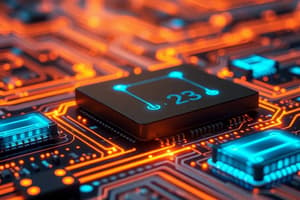Podcast
Questions and Answers
What is the atomic structure of semiconductors like?
What is the atomic structure of semiconductors like?
- It is a random arrangement of atoms
- It consists of periods containing eight atoms arranged in a tetrahedral form (correct)
- It is a linear arrangement of atoms
- It forms a hexagonal lattice
What are some common semiconductor materials?
What are some common semiconductor materials?
- Iron and lead
- Plastic and rubber
- Aluminum and copper
- Silicon, germanium, and gallium arsenide (correct)
What components are based on semiconductors?
What components are based on semiconductors?
- Transistors, diodes, and integrated circuits (ICs) (correct)
- Resistors, capacitors, and inductors
- Relays, switches, and connectors
- Coils, transformers, and antennas
What do circuits do in electronic devices?
What do circuits do in electronic devices?
Which type of circuit operates using continuous electrical signals?
Which type of circuit operates using continuous electrical signals?
What are the primary values that discrete electrical signals in digital circuits can take on?
What are the primary values that discrete electrical signals in digital circuits can take on?
What is the primary advantage of digital electronics?
What is the primary advantage of digital electronics?
Which logic utilizes logical gates like AND, OR, and NOT in the design of digital circuits?
Which logic utilizes logical gates like AND, OR, and NOT in the design of digital circuits?
What principles allow digital circuits to function reliably and efficiently, even in the presence of noise and other disturbances?
What principles allow digital circuits to function reliably and efficiently, even in the presence of noise and other disturbances?
What has the development of digital electronics given rise to?
What has the development of digital electronics given rise to?
Flashcards are hidden until you start studying
Study Notes
Exploring Electronic: Semiconductors, Circuits, and Digital Electronics
Electronics, a field that encompasses the study and manipulation of electric charges and their behavior, is a vital and ever-growing industry. In our exploration of electronic concepts, we'll dive into the fundamental aspects of semiconductors, circuits, and digital electronics.
Semiconductors
Semiconductors are materials with unique electrical properties that lie between those of conductors (like metals) and insulators (like ceramics). Their ability to conduct electricity under specific conditions stems from their atomic structure and the presence of energy levels that allow for the movement of electrons. Some common semiconductor materials include silicon, germanium, and gallium arsenide.
The inner structure of semiconductors comprises a crystalline lattice formed by a series of repeating units called periods. Each period contains eight atoms arranged in a tetrahedral form, known as the diamond lattice. This arrangement allows for the movement of electrons through the material when an external source of energy (such as heat or light) causes them to jump from one energy level to another.
Semiconductors provide the foundation for many electronic devices, including transistors, diodes, and integrated circuits (ICs).
Circuits
Circuits are the building blocks of electronic devices, responsible for controlling and manipulating the flow of electrical signals. There are two main types of circuits: analog circuits and digital circuits.
-
Analog circuits: Analog circuits operate using continuous electrical signals, which can take on any value within a specific range. They are designed to process and amplify signals, such as audio or video signals, or to generate specific characteristics (like voltage or current). Examples of analog circuits include amplifiers, filters, and oscillators.
-
Digital circuits: Digital circuits process and manipulate discrete electrical signals that can only take on specific values, such as 0 or 1. These circuits are based on binary logic, where the behavior of the circuit is determined by a combination of input signals. Digital circuits are the foundation of digital electronics, including computers, smartphones, and other modern devices.
Digital Electronics
Digital electronics is a subfield of electronics that focuses on the design, operation, and analysis of digital circuits. The primary advantage of digital electronics is its ability to represent and manipulate information in the form of binary data (0s and 1s). These representations are highly reliable and can be easily processed and transmitted.
The design of digital circuits utilizes the principles of combinational logic (using logical gates, like AND, OR, and NOT) and sequential logic (using flip-flops and registers). Together, these principles allow digital circuits to function reliably and efficiently, even in the presence of noise and other disturbances.
Digital electronics powers a wide range of electronic devices, and its development has given rise to modern computer systems, communication networks, and embedded systems.
In conclusion, the study of electronics, including semiconductors, circuits, and digital electronics, is the foundation for countless electronic devices and systems. As technology continues to evolve, so too will the challenges and opportunities presented in this dynamic field. The continued discovery and development of new materials, circuits, and digital systems will help drive the progress of electronics in the decades to come.
Studying That Suits You
Use AI to generate personalized quizzes and flashcards to suit your learning preferences.




